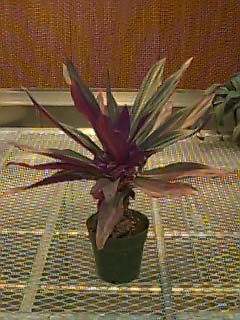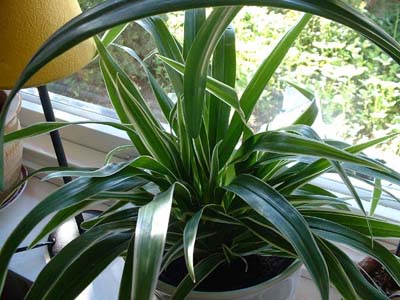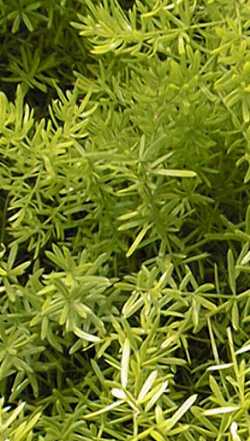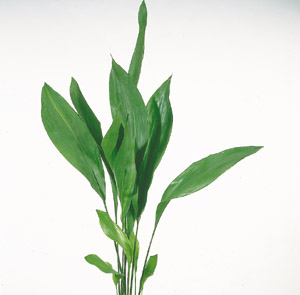|
Pelargonium
exists in many different colors. Red, pink, white
with many shades in between. The Pelargonium wants a lot of light,
but not direct sunlight. Leave it outside in the garden during the
summer (if you protect it properly).It must be a little damp all
summer, but during the winter you can let it dry out in between
the times you water it.
Monstera (Monstera Deliciosa) is a very pretty plant. The
leaves can grow to be 60 cm across. They usually have big holes
in them, which indicates it comes from a windy place originally.
The plant can grow to 230 cm indoors but grows slowly. It's really
a creeper. To make it grow upright, you'll need to support it with
a stick. On healthy specimens eventually there will be air roots,
which are meant to steady the plant. Don't remove them. Monstera
is among the plants most easily cared for. Just make sure you have
plenty of space. It can stand in semidarkness. 15 - 24 ° C.
Don't water it too much! Once a week during the summer and once
every fortnight during the winter. Replant in the spring, if needed.
This plant can live for many years.
Hoya (Asclepiadaceae) One of my personal favorites
is Hoya, the wax flower. The flowers look as if they're made of
porcelaine and has a wonderful fragrance. The older the plant the
more it blooms. The Hoya needs a lot of light and warmth to bloom.
The roots don't want to stand in water, but it wants plenty of water
while it blooms. The Hoya is rarely a victim of parasites.
 
Boat Lily/Moses in the cradle/Oyster plant (Commelinaceae)
Rhóeo spathácea This is a very hardy plant. It likes
a place in the light, though not direct sunlight. Since the plant
originally comes from marshlands it wants plenty of water. It grows
fast and needs a fertilizer once a week. The Boat Lily doesn't often
fall prey to diseases or parasites.

Spider Plants Spider plants, Chlorophytum comosum, need bright
natural light but will sunburn if grown in direct sunlight. They
also do very well when grown under grow lights, butwill be reluctant
to produce the plantlets unless you decrease their light hours to
simulate the naturally shorter days of fall, when they normally
produce their 'babies'. Keep the soil evenly moist, but never soggy.
They also prefer to be in a cooler (55-65 degrees F.) room but will
tolerate warmer temperatures. Feed the plant every 3 or 4 months
with any house plant fertilizer.
Spider plants are generally easy to grow, and mature plants are
quite beautiful until the tips brown out. Tip burn is usually caused
chemicals in the water. If you are using city water for your plants
it has been chlorinated, and very likely has been treated with fluoride,
either of which will cause the burn. Using rainwater or distilled
water will take care of this problem. Over fertilizing will also
damage the plant, so when you feed it, use 1/2 of the recommended
strength.
 
Asparagus Ferns Asparagus densiflorus 'Sprengeri' Asparagus
d. 'Sprengeri' (Liliaceae) This is a very popular plant that is
easy to care for.
The Asparagus Fern likes to stand in light shade and can be placed
some distance away from the window. It's one of the best green plants
for a piedestal. During the summer it wants plenty of water but
less during the winter.
The Asparagus is rarely attacked by parasites. Like all asparguses
it lacks actual leaves. Instead it has something called phylloclads,
i e fine, soft needles. It can wither away and grown back again,
so don't throw it out if it looks dead.
Dracaena (Liliaceae) The Dracaena is very hardy and
it's almost impossible to fail with it. You can put it practically
anywhere except in direct sunlight, even some distance into the
room. Water it all year round. This plant rarey suffers from disease
or parasites.
Christmas Cactus Schlumbergera x buckleyi This most
striking flowering gift plant is actually a member of the Cactus
family. A curious plant, it grows on the trees in the tropical rain
forest. It is well loved for its stunning display of brightly colored
flowers that appear during the Christmas season. Schlumbergera can
be distinguished from the other epiphytic cacti; S. gaertneri and
Zygocactus truncatus in that its stem segments have scalloped margins
and the blooms form only at the stem tips.
Ficus This plant is very popular, in public buildings
and in private homes. They are very easy to care for. The Ficus
can live for a very long time and get big. The biggest specimens
can be found mainly in public buildings where there is plenty of
space. Do not water too much. Don't leave them in water. They like
a shower now and again.
The Ficus can be found in many different forms, with big leaves
or small ones. The Ficus Natasha has small leaves and since it doesn't
grow to be so big, it's a better choice for a private home.
All Ficuses like to stand in the light but not in direct sunlight.
If the room is well lit, you can put the plant some distance away
from the window, but if you do you'll need some kind of artificial
lighting during the winter.

Sansevieria/Good Luck Plant, mother-in-law's
tongue, snake plant, sansevieria trifasciata, sansevieria zeylandica
- agavaceae (dracaenaceae).
This herbaceous tropical perennial consist of erect, strap - like
leaves up to 5' tall. The foliage is stiff, succulent, mottled,
blotched or lined; many shapes and sizes. There are several varieties
of the good luck plant such as S. trifasciata laurentii "compacta
goldeana", S. trifasciata "Hahnii", S. trifasciata
Golden Hahnii and S. arborescens. The snake plant is often mottled
dark green and cream with small white fragrant flowers.
It produces a berry as the fruit.
Aspidistra This hardy plant needs the least effort
to succeed. A native of China, it has large, broad, dark green leaves.
Where the winters are mild, this plant can be placed outside in
shady areas. Large, well-established plants occasionally produce
interesting flowers that grow low among the leaves and are purplish-brown.
A. elatior variegata produces foliage that is variegated with green
and pale yellow.
Crassula
The Jade Plant (Crassula argentea) originated in south Africa,
but has been cultivated as a house plant in Europe and America for
over a hundred years. Generally, it is a very easy and productive
plant to grow, provided its needs are understood and met. Jades,
and all other Crassulas are succulent plants, in that they have
the ability to store water in its leaves, stems, and roots.
Jade plants are best grown in very bright sunlight with low humidity,
however if the plant is accustomed to dimmer light, you must move
it into the sun in stages.
Umbrella Plant/Cyperus alternifolia is semi-aquatic
and requires a very moist soil and a medium light exposure. The
plant is often grown with the pot standing in a container of water.
Do not expose the Umbrella Plant to temperatures below 55 degrees.
When repotting is needed, do it in March. Propagation is by division,
seeds, or cuttings made from terminals.
Kalanchoë blossfeldiana
Native to Africa and Madagascar These blooming plants’
flowers last for many weeks. The plant grows 8 to 12 inches
tall with masses of small four-petaled leaves that are red, orange,
coral, gold, yellow and purple. They have thick, waxy leaves
with a succulent appearance.
Water when soil feels dry to the touch and drain excess water from
tray. Plants can withstand periods of dry soil. Maintain
flower color with bright, indirect sunlight daily for at least four
hours. Remove dead leaves and spent blossoms.
This plant can be difficult to bring into bloom again since rebloom
is determined by the amount and length of total darkness every 24
hours for up to four months.
|





